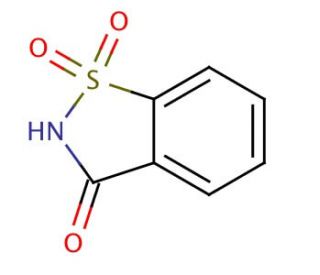

Saccharin (CAS 81-07-2)
LINKS RÁPIDOS
A sacarina é amplamente utilizada na investigação centrada na perceção do gosto e nos mecanismos biológicos subjacentes aos receptores do gosto doce. Este edulcorante artificial é estudado pela sua capacidade de se ligar e ativar estes receptores, que estão localizados nas papilas gustativas da língua, fornecendo informações sobre os complexos processos de sinalização e perceção do sabor. A investigação sobre a sacarina também explora os seus efeitos nas respostas metabólicas do organismo, em particular a forma como influencia a libertação de insulina e o metabolismo da glucose, apesar de não ser um açúcar. Além disso, a sacarina é utilizada em estudos ambientais para traçar as vias e a persistência dos edulcorantes artificiais nos sistemas hídricos, ajudando a avaliar o seu impacto nos ecossistemas. As investigações sobre a estabilidade e a degradação da sacarina em várias condições ambientais contribuem ainda mais para a compreensão dos seus efeitos ambientais a longo prazo.
Saccharin (CAS 81-07-2) Referencias
- Os riscos da sacarina para a saúde revisitados. | Ellwein, LB. and Cohen, SM. 1990. Crit Rev Toxicol. 20: 311-26. PMID: 2202324
- Novos derivados da sacarina como inibidores da tirosinase. | Gençer, N., et al. 2012. Bioorg Med Chem. 20: 2811-21. PMID: 22494841
- O sabor da sacarina condiciona a preferência de sabor em ratos desmamados. | Ueji, K., et al. 2016. Chem Senses. 41: 135-41. PMID: 26514409
- Os efeitos toxicológicos da sacarina em ensaios de genotoxicidade a curto prazo. | Arnold, DL. and Boyes, BG. 1989. Mutat Res. 221: 69-132. PMID: 2671710
- Síntese de novos derivados de sacarina. | Rankin, GM. and Poulsen, SA. 2017. Molecules. 22: PMID: 28333118
- Procura e preferência de heroína e sacarina em ratos. | Schwartz, LP., et al. 2017. Drug Alcohol Depend. 178: 87-93. PMID: 28645064
- Medição dos metabolitos da sacarina e do trans-resveratrol na urina como marcadores de adesão ao consumo de pequenas quantidades de suplementos de nutrientes à base de lípidos. | Weinborn, V., et al. 2021. J Agric Food Chem. 69: 1107-1114. PMID: 33439009
- Dissecação da autoadministração operante de álcool utilizando o procedimento de desvanecimento da sacarina. | Calleja-Conde, J., et al. 2023. Neuropsychopharmacol Rep. 43: 12-22. PMID: 36727594
- A controvérsia da sacarina. | Kalkhoff, RK. and Levin, ME. 1978. Diabetes Care. 1: 211-22. PMID: 400131
- Metabolismo da sacarina e tumorigenicidade. | Sweatman, TW. and Renwick, AG. 1979. Science. 205: 1019-20. PMID: 472722
- Bioensaios de duas gerações com sacarina. | Arnold, DL. 1983. Environ Health Perspect. 50: 27-36. PMID: 6347682
- Sacarina: uma perspetiva toxicológica e histórica. | Arnold, DL., et al. 1983. Toxicology. 27: 179-256. PMID: 6353664
- O gosto aversivo da sacarina em ratos: provas e implicações. | Dess, NK. 1993. Neurosci Biobehav Rev. 17: 359-72. PMID: 8309647
Informacoes sobre ordens
| Nome do Produto | Numero de Catalogo | UNID | Preco | Qde | FAVORITOS | |
Saccharin, 100 mg | sc-212902 | 100 mg | $173.00 | |||
Saccharin, 1 g | sc-212902A | 1 g | $235.00 | |||
Saccharin, 10 g | sc-212902B | 10 g | $286.00 |
